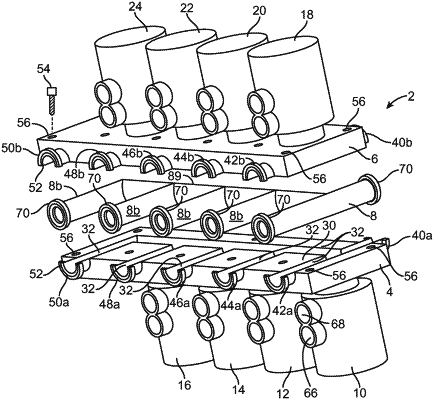| CPC F16K 7/04 (2013.01) [F16K 3/30 (2013.01); F16K 7/00 (2013.01); F16K 7/045 (2013.01); F16K 7/06 (2013.01); F16K 7/07 (2013.01); F16K 11/027 (2013.01); F16K 11/10 (2013.01); F16K 27/003 (2013.01); F16K 31/0655 (2013.01); F16K 7/066 (2013.01); Y10T 137/60 (2015.04); Y10T 137/87153 (2015.04); Y10T 137/87684 (2015.04); Y10T 137/87708 (2015.04); Y10T 137/87885 (2015.04); Y10T 137/87925 (2015.04)] | 20 Claims |

|
1. An encapsulated valve system for pressurized pharmaceutical or biological liquid fluids comprising:
a first housing having a first facing surface, the first facing surface comprising a plurality of pathways formed as a recess within the first facing surface, wherein one of the plurality of pathways is a common line and wherein another of the plurality of pathways comprises at least one branch line;
a second housing having a second facing surface, the second facing surface comprising a plurality of pathways formed as a recess within the second facing surface, wherein the plurality of pathways formed in the recess within the second facing surface mirror the plurality of pathways formed in the recess within the first facing surface and wherein the plurality of pathways defined by the respective recesses of the first facing surface and the second facing surface have a substantially constant cross-section along lengths thereof;
a disposable conduit comprising un-reinforced polymer tubing having a common line and at least one branch line connected to the common line and configured to be interposed between the first and second housing portions and disposed within the recess of the first facing surface and the recess of the second facing surface, the disposable conduit configured to carry a pressurized liquid fluid therein that would otherwise form an aneurysm in the disposable conduit in the absence of the first housing and second housing forming an exoskeleton for the same;
a common line pinch valve actuator mounted on one of the first housing or the second housing, wherein the common line pinch valve actuator comprises an automatically-controlled pinching element configured to pinch the disposable conduit along a point of the common line;
at least one branch line pinch valve actuator mounted on one of the first housing or the second housing, wherein the at least one branch line pinch valve actuator comprises an automatically-controlled pinching element configured to pinch the disposable conduit at a location along the at least one branch line; and
one or more removable fasteners configured to secure the first housing and the second housing to one another and form the exoskeleton around the disposable conduit, wherein no portion of the disposable conduit between the first housing and the second housing is exposed to the external environment and not encapsulated by the exoskeleton.
|